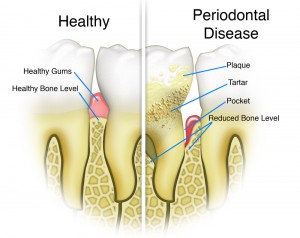 Periodontal disease is a degenerative infection of the oral tissue supporting your teeth. It is normally caused by poor oral hygiene. After years of neglect, a build-up of plaque eventually forms under the gum line. This stage is called gingivitis; it’s the mildest form of periodontitis. It usually goes unnoticed until physical symptoms begin.
Periodontal disease is a degenerative infection of the oral tissue supporting your teeth. It is normally caused by poor oral hygiene. After years of neglect, a build-up of plaque eventually forms under the gum line. This stage is called gingivitis; it’s the mildest form of periodontitis. It usually goes unnoticed until physical symptoms begin.
Symptoms of gingivitis include swollen gums and light bleeding when brushing or flossing your teeth. As gingivitis worsens your gums may bleed freely when brushing or eating. If these conditions persist, you could lose your teeth. The plaque grows slowly but surely, lifting the gum away from the bone. That creates pockets around your teeth. Those pockets are perfect food traps. When food becomes trapped beneath the gum line, it causes more discomfort and bleeding. If you try to dislodge the trapped food by flossing, it can make the pockets even worse. Continue reading


